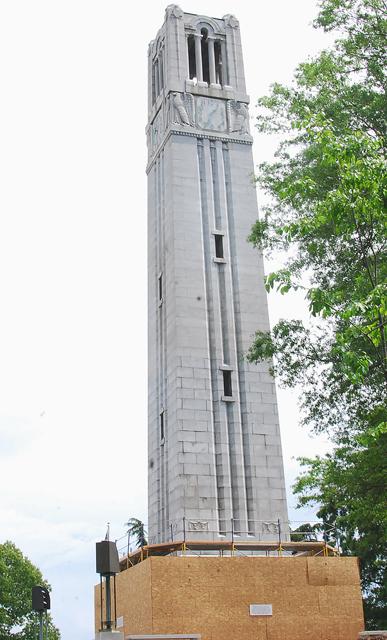Like many other buildings around for more than 60 years, the Memorial Belltower is getting what some consider a much needed renovation.
Although it took thirty years to construct, the Belltower has been an icon for N.C. State since it was completed in 1949. In the decades that followed, water seeped inside the building and harmed some of its surfaces, according to Andy Snead, director of Design and Construction Services.
According to Snead, this is the first of what will likely be four phases of repairs. This initial phase aims to resolve the problem of water entering the tower, especially through its small windows and leaky mortar joints. This water intrusion, if not addressed, could lead to greater structural problems.
“This is the first phase of the Belltower repairs, which involves sealing the building envelope, an industry term that essentially means keeping water and humidity on the outside of the building,” Snead said.
While Snead said the timing of the repairs isn’t great since graduation is approaching, the Belltower will be available for photos during graduation.
“Construction activity will cease all work during the week of graduation and then resume for completion by June 1, 2011,” Snead said.
The current budget for repairs of $13,000 will allow the most pressing needs in the most sensitive areas of the building to be taken care of first. However, according to Snead, all of the maintenance and repair work needed could cost upwards of $1 million. That includes repairs to the courtyard area, installation of windows at the top of the Belltower, a complete resealing of all masonry joints and cosmetic work on the shrine room.
The phased approach will ensure the most critical items are taken care of first, says Snead.
“The scope of this phase is to stop water intrusion through the wall into the lower part of the tower and shrine room where the damage is most pronounced,” Snead said. “The age of the mortar joints requires that they be tuck pointed to restore the integrity of the joint.”
Tuckpointing is a form of joint repair, according to Snead. The old or failing mortar is removed and replaced with new mortar. When the mortar in the joints fail, moisture can seep through the joint and ultimately find its way into the structure.
“This is normal in buildings as they age, and we perform repairs of this nature on a regular basis in older buildings on campus,” Snead said.
The first phase accounts for the lower 18 feet of the tower to have the masonry joints cleaned and repaired, according to Snead.
“Scaffolding has been erected to that approximate height around the tower, and a plywood screen covers the lower 12 feet for pedestrian protection,” Snead said.
However, Snead said the goal is for the new mortar to be unnoticeable—even after the extensive repairs.
“Our goal will be for the repairs to be unnoticeable, except perhaps by an engineer or someone in the construction industry who has experience with masonry work,” Snead said. “We worked diligently to ensure the new mortar will match the existing mortar.”








